The assessment of Customer satisfaction
Background of the research
Managing customer satisfaction and meeting their expectations are the main motive of the Churchill, Jorvik and judge Court Hotels in York where the managers in the hotels try to satisfy the customers by delivering high quality hospitality service as per their needs and preferences. The research focuses three hotels, Churchill, Jorvik and judge Court Hotels where the main motive of the hotels is to maximise the quality of their services so that it is easy to satisfy the customers. In this recent years, there is high competitive in the global hospitality industry and it is difficult for the hotels to gain high competitive advantage and retain the customers for long run (Saleem and Raja, 2014).
It is therefore beneficial for the hotel managers to analyse the needs and preferences of the guests and develop their services so that it is easy to match their expectations and maximise their satisfaction level of the customers (Hapsari, Clemes and Dean, 2016). Through this study, it is possible to identify the customer’s perception as well as the existing gap between the service quality and customer’s perception. The study also needs to be conducted due to reducing the existing gap and improve the organisational service of the hotels in York so that it is possible for them to strengthen their customer’s base. In the recent era of globalisation, there is high demand of the hospitality service and there is an opportunity for all the three hotels, Churchill, Jorvik and judge Court Hotels to maximise their profitability and secure future sustainable development in long run through high customer’s retention. It is therefore rationale to conduct the research in order to analyse the customer’s perception and hospitality service quality in the Churchill, Jorvik and judge Court Hotels.
Aims and specific objectives of the research
The aim of the research is to assess the expectation of the guests, perception regarding the service provide by the hotels and acknowledge SERVQUAL components for evaluating the quality of the hospitality service and customer retention in the Churchill, Jorvik and judge Court Hotels in York.
The objectives of the researcher are,
- To identify the perception of the guests in the hotels
- To assess the expectations and requirements of the customers in the hospitality industry mainly in the Churchill, Jorvik and judge Court Hotels in York
- To identify the SERVQUAL components for evaluating the service quality of the Churchill, Jorvik and judge Court Hotels in York
- To acknowledge the relationship between the service quality and customer’s retention
- To recommend some suitable suggestions to close the gap in SERVQUAL model and improve service quality for high customer retention
Research Questions
- What are the perception of the customers regarding the service offered by the Churchill, Jorvik and judge Court Hotels in York?
- What are main gaps in the service provided by Churchill, Jorvik and judge Court Hotels in York which can be evaluated through SERVQUAL components?
- What is the connection between the service quality and customer retention in the Churchill, Jorvik and judge Court Hotels in York?
- What are the suggested recommendations for improving service quality of the Churchill, Jorvik and judge Court Hotels in York and reduce the gap in SERVQUAL components so that there will be high customer’s retention and maximisation of customer’s satisfaction?
Research hypothesis
- There is proper relationship between the service quality and customer retention
- There is no such connection between customer’s retention and service quality
Literature review
Service quality:
Service quality of the organisations is important through which the corporate firms try to manage their customers in long run. The service quality of the organisations mainly depends on different factors such as organisational resources and capabilities, employee’s skills, attention to the customers, understanding the customer’s needs and preferences, and organisational performance (Han and Hyun, 2015).
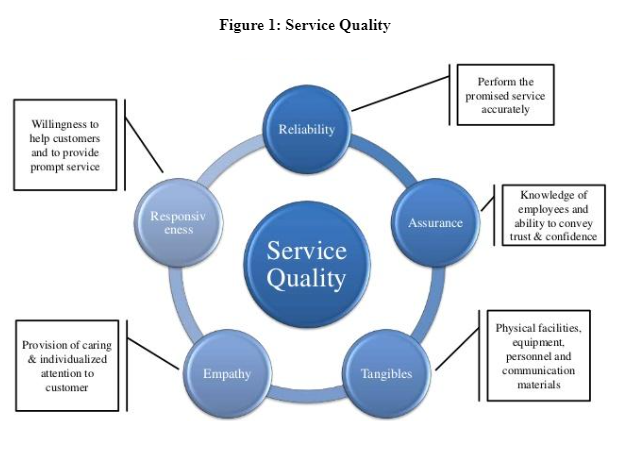
The multinational corporate firms aim at maximising the quality of the service that they provide for establishing the business successfully and creating values for over social communities and other stakeholders engaged with the business. Through improving the service quality of the organisations, it is possible for them to gain high competitive advantage over other competitive firms (Kim, Vogt and Knutson, 2015).
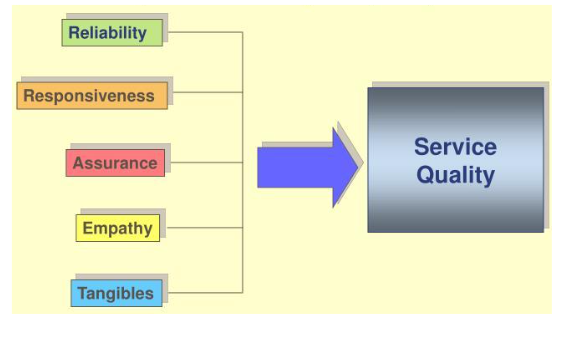
SERVQUAL model:
The service quality of the organisations mainly depends on the organisational infrastructure and the skills of the employees for serving the customers. The service quality of the companies depends on the reliability, responsiveness, assurance, tangible and empathy where the employees need to be efficient to treat the customers proficiently so that the satisfaction level of the customers can be maximised.
It is necessary for the organisations to be concerned about the needs and preferences of the customers where the employees are responsible to provide efficient service as [per the customer’s requirements. Reliability and empathy are important to communicate with the customers and additionally the employees need to be concerned about the quality of service, durability, and tangibles (Dedeoğlu and Demirer, 2015).

Gap model:
Through this model, it is possible to demonstrate the gap existing between the customer’s expectations and the services provided by the organisations. The organisations try to improve market communication in order to identify the needs and preferences of the customers (Oh, and Kim, 2017).
The management team of the companies in this regard try to understand the perception of the customers and improve the quality of their service so that it is possible meet the customer’s expectations. If there is gap between the customer’s expectations and the perceived service, the companies try to meet the gap by improving their service quality.
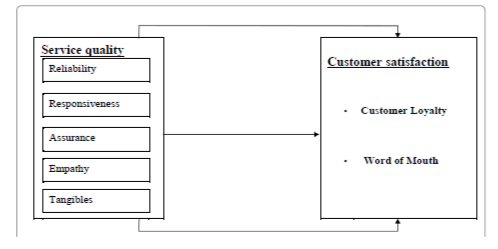
Relationship between customer’s satisfaction and service quality:
Quality service of the organisations has direct impacts on the customers where the corporate firm can satisfy the customers and retain them for long run. Hereby, there is positive relationship between the quality service and customer’s satisfaction which in turn helps to strengthen the customer’s base of the firms (Pizam, Shapoval and Ellis, 2016).
Reliability, responsiveness, cooperation and communication with the customers are helpful to improve customer’s loyalty and maximise the satisfaction level of the customers. This further increases the chance of word of mouth which provides a scope to the companies to retain old as well as new customers in the market (Ross, 2017). Hereby, there is positive relationship between the customer’s satisfaction and service quality of the firms which is also effective for strengthening the customer’s base of the businesses.
Research methodology
It is essential to develop effective research methodology so that the researcher can collect authentic and relevant data and information which will be helpful for the researcher to analyse the above motioned research topic. In this study, deductive research approach is beneficial to evaluate the findings on the basis of existing literatures. In addition to these, the researcher in this regard research selects both the primary and secondary data collection technique. The secondary data can be collected from the literature sources such as books, journals, articles, online newspapers and business reports and on the other hand, the primary data can be gathered through survey questionnaire. In this regard, the researcher develops survey questionnaires and there are 22 questions for the customers through which it is possible to collect the information directly from the customers.
This is an effective technique for collecting primary data from the customers which further helps the researcher to evaluate the quality of service in the hotels in York and its impacts on the customer’s retention. The researcher tries to analyse the collected information by choosing quantitative technique by representing the collected information through tables, charts and graphs through which it is possible to evaluate the customer’s perceptions. Moreover, the SERVQUAL model in this regard is applicable where the researcher will evaluate the customer’s perception and analyse the quality of the hospitality service provided by the Churchill, Jorvik and judge Court Hotels in York.
Ethical consideration
As per the ethical consideration, the researcher needs to manage research ethics in order to complete the research successfully. In this regard, the researcher will try to treat the customers fairly and shoe honesty and integrity in collecting the data. The researcher will not force the customers to participate in the survey strategy, but it will be beneficial for the researcher top convince the customers to take part so that it will be helpful for the hotels to improve their service. Moreover, the researcher ensures that the data is utilised only for academic purpose not fir any business purpose. In this regard, the researcher will follow the data Protection Act 1998 in order to protect the customer’s data so that it is possible to build trust and loyalty among the customers and increase the participation rate of the customers. The researcher in this regard also will choose the valid and reliable data which will be beneficial for evaluating the customer’s perception and expectations of the guests in the Churchill, Jorvik and judge Court Hotels in York.
Anticipated outcomes
There is high impact of the organisational efficiency in the Churchill, Jorvik and judge Court Hotels in York on the performance level of the hotels and this further helps the companies to provide the best quality hospitality service to the customers. In this regard, the hotels also try to improve their service by acknowledging the customer’s needs and preferences as well as the understanding the feedback of the consumers. This is a crucial step of the hotels through which they aim at maximising the value of the customers. There is also a positive relationship between the customer’s satisfaction level and service quality and the hotels in this context focus on maximising the values of the customers so that the demand of the consumers will be enhanced for the organisational quality service. the Churchill, Jorvik and judge Court Hotels in York also will aim a retaining more clients for growing the business successfully and gaining high competitive advantage so that it is possible for the organisations to run the business proficiently and strengthen their customer’s base.
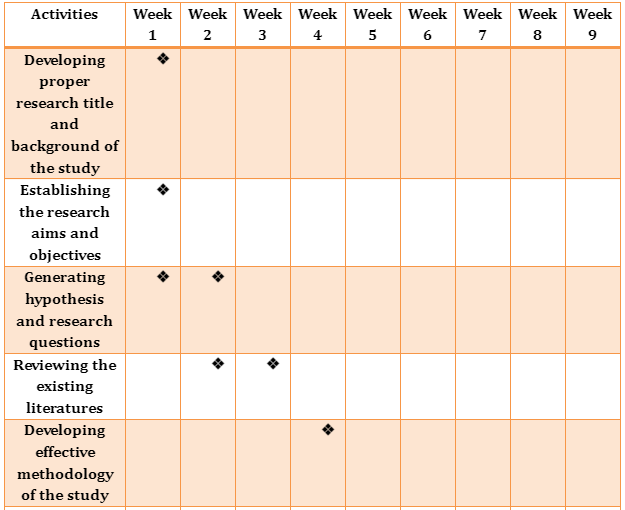
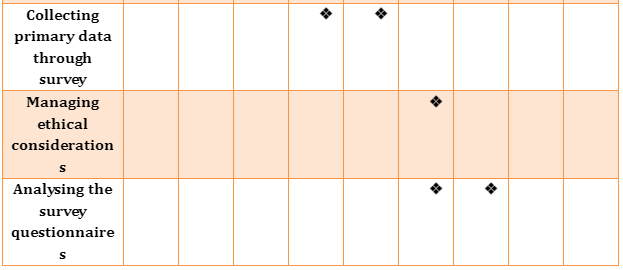
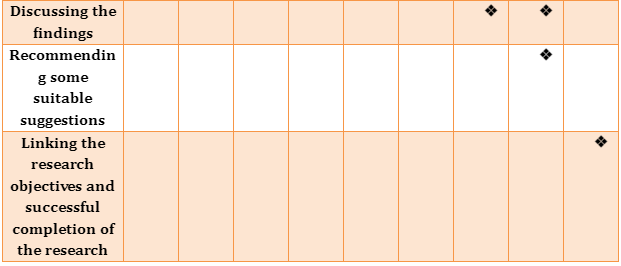
Reference List
- Ashraf, S., Ilyas, R., Imtiaz, M. and Ahmad, S., 2018. Impact of Service Quality, Corporate Image and Perceived Value on Brand Loyalty with Presence and Absence of Customer Satisfaction: A Study of four Service Sectors of Pakistan. International Journal of Academic Research in Business and Social Sciences, 8(2), pp.452-474.
- Berezina, K., Bilgihan, A., Cobanoglu, C. and Okumus, F., 2016. Understanding satisfied and dissatisfied hotel customers: text mining of online hotel reviews. Journal of Hospitality Marketing & Management, 25(1), pp.1-24.
- Dedeoğlu, B.B. and Demirer, H., 2015. Differences in service quality perceptions of stakeholders in the hotel industry. International Journal of Contemporary Hospitality Management, 27(1), pp.130-146.
- Han, H. and Hyun, S.S., 2015. Customer retention in the medical tourism industry: Impact of quality, satisfaction, trust, and price reasonableness. Tourism Management, 46, pp.20-29.
- Hapsari, R., Clemes, M. and Dean, D., 2016. The mediating role of perceived value on the relationship between service quality and customer satisfaction: Evidence from indonesian airline passengers. Procedia Economics and Finance, 35, pp.388-395.
- Kim, M., Vogt, C.A. and Knutson, B.J., 2015. Relationships among customer satisfaction, delight, and loyalty in the hospitality industry. Journal of Hospitality & Tourism Research, 39(2), pp.170-197.
- Lu, C., Berchoux, C., Marek, M.W. and Chen, B., 2015. Service quality and customer satisfaction: qualitative research implications for luxury hotels. International Journal of Culture, Tourism and Hospitality Research, 9(2), pp.168-182.
- Oh, H. and Kim, K., 2017. Customer satisfaction, service quality, and customer value: years 2000-2015. International Journal of Contemporary Hospitality Management, 29(1), pp.2-29.
- Pizam, A., Shapoval, V. and Ellis, T., 2016. Customer satisfaction and its measurement in hospitality enterprises: a revisit and update. International Journal of Contemporary Hospitality Management, 28(1), pp.2-35.
- Rahimi, R. and Kozak, M., 2017. Impact of customer relationship management on customer satisfaction: The case of a budget hotel chain. Journal of Travel & Tourism Marketing, 34(1), pp.40-51.
- Ross, J.E., 2017. Total quality management: Text, cases, and readings. London: Routledge.
- Saleem, H. and Raja, N.S., 2014. The impact of service quality on customer satisfaction, customer loyalty and brand image: Evidence from hotel industry of Pakistan. Middle-East Journal of Scientific Research, 19(5), pp.706-711.
